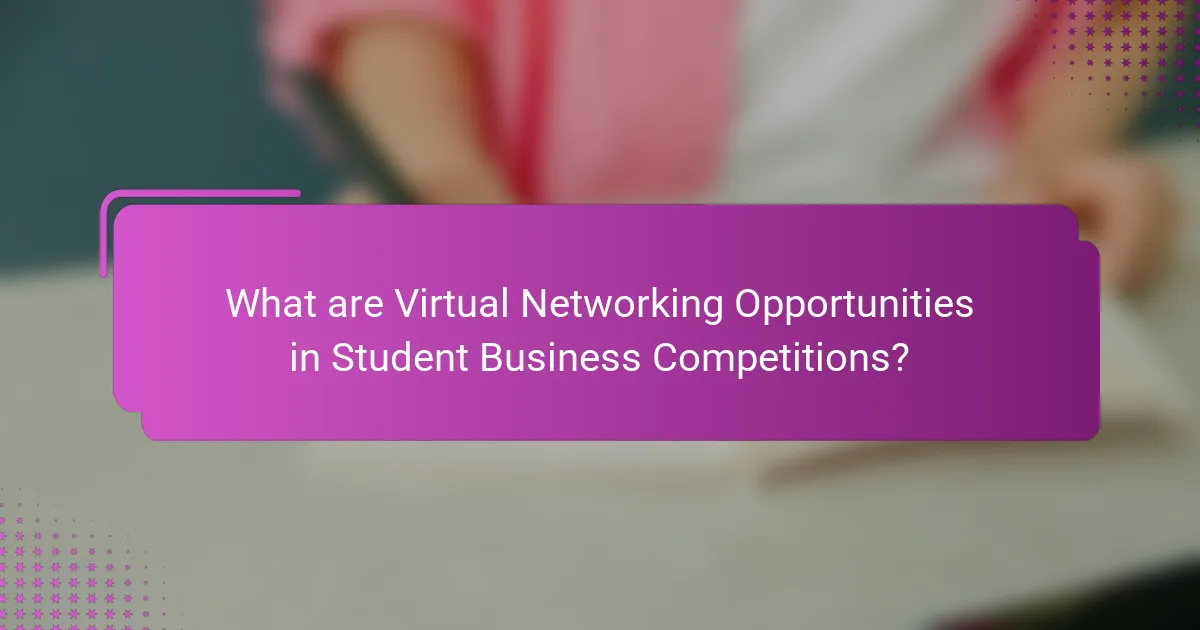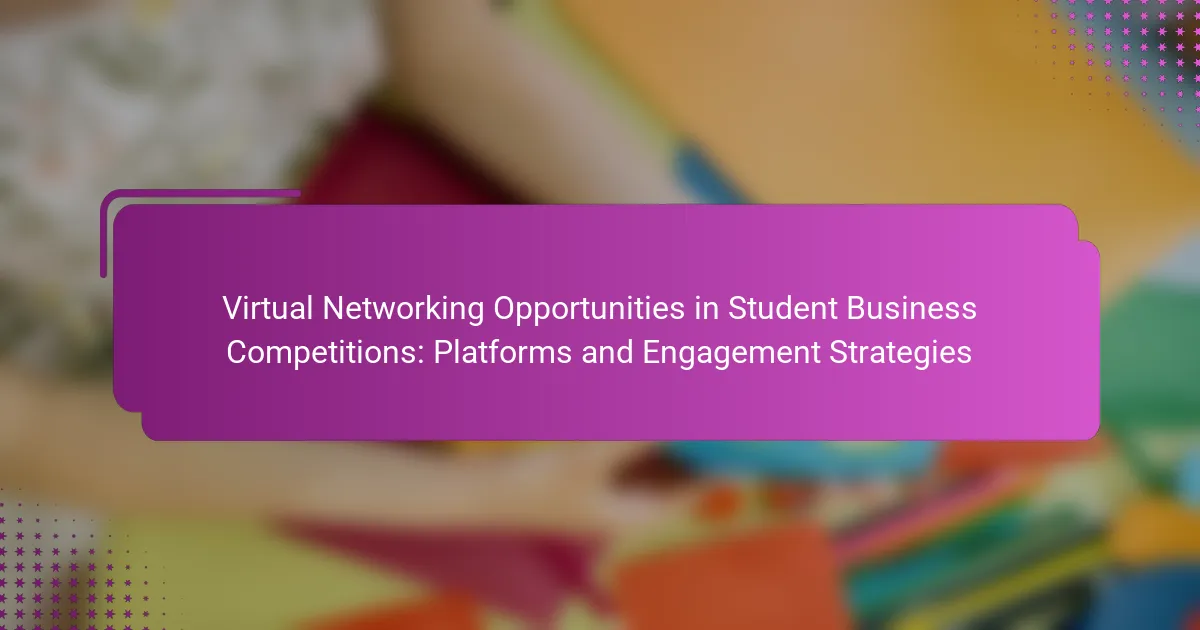Virtual networking opportunities in student business competitions serve as essential platforms for fostering connections among participants, including students, mentors, and industry professionals. These opportunities encompass webinars, online forums, and social media groups that enhance collaboration and knowledge sharing. Research highlights that 70% of students deem networking vital for career advancement. Effective engagement strategies, such as scheduled networking sessions and interactive Q&A panels, play a crucial role in building meaningful relationships and enriching learning experiences. This article will explore the significance of these networking opportunities and the strategies that facilitate effective engagement.

What are Virtual Networking Opportunities in Student Business Competitions?
Virtual networking opportunities in student business competitions are platforms that facilitate connections among participants. These opportunities include webinars, online forums, and social media groups. They enable students to interact with peers, mentors, and industry professionals. Virtual networking enhances collaboration and knowledge sharing. Research indicates that 70% of students find networking crucial for career advancement. Effective engagement strategies include scheduled networking sessions and interactive Q&A panels. These methods foster meaningful relationships and enhance learning experiences.
How do these opportunities enhance student engagement?
Virtual networking opportunities enhance student engagement by providing interactive platforms for collaboration. These platforms facilitate real-time communication among students, mentors, and industry professionals. Engaging in discussions and sharing ideas fosters a sense of community. Students can participate in networking events that simulate real-world business environments. This exposure increases their confidence and prepares them for future careers. Research indicates that students involved in such opportunities report higher satisfaction and motivation levels. A study by the National Association of Colleges and Employers found that networking opportunities significantly boost student engagement and career readiness.
What specific skills can students develop through virtual networking?
Students can develop several specific skills through virtual networking. These skills include effective communication, which is crucial for articulating ideas clearly. They also enhance their ability to build relationships in a digital context. Networking fosters collaboration skills, enabling students to work effectively with peers online. Additionally, students improve their adaptability by navigating various virtual platforms. Time management skills are honed as students learn to balance networking with other responsibilities. Furthermore, students gain confidence in presenting themselves and their ideas in virtual settings. Research shows that 85% of jobs are filled through networking, emphasizing the importance of these skills for future career opportunities.
How do virtual networking opportunities differ from traditional networking?
Virtual networking opportunities differ from traditional networking primarily in their format and accessibility. Virtual networking takes place online, allowing participants to connect from various locations. This format increases the number of potential connections, as geographical barriers are removed. Traditional networking typically occurs in person, which can limit attendance based on location and availability.
Moreover, virtual networking often utilizes digital tools like video conferencing and chat platforms. These tools can facilitate real-time interactions and provide features like screen sharing. Traditional networking relies on face-to-face conversations and physical presence, which can lead to more personal connections.
Additionally, virtual networking events can accommodate larger audiences, often leading to a more diverse pool of participants. For example, a virtual conference can host hundreds or thousands of attendees simultaneously. In contrast, traditional networking events usually have limited space, restricting the number of participants.
Overall, the key differences lie in the format, accessibility, interaction methods, and audience size. These factors significantly influence the networking experience in both environments.
Why are platforms essential for virtual networking in student competitions?
Platforms are essential for virtual networking in student competitions because they facilitate communication and collaboration among participants. These platforms provide tools for messaging, video conferencing, and file sharing. They enable students to connect with peers, mentors, and industry professionals. Effective networking can lead to valuable partnerships and insights. Research shows that 70% of students find networking crucial for career development. Platforms also allow for real-time feedback and support, enhancing the overall competition experience. They create a centralized space for resources and information sharing. Overall, platforms significantly enhance the networking potential in virtual environments.
What types of platforms are commonly used for virtual networking?
Common platforms used for virtual networking include video conferencing tools, social media networks, and professional networking sites. Video conferencing tools like Zoom and Microsoft Teams allow real-time interaction. Social media networks such as LinkedIn provide opportunities for connection and engagement. Professional networking sites like Meetup facilitate group interactions based on shared interests. Each platform offers unique features that enhance networking experiences. Video conferencing enables face-to-face communication, while social media allows for broader outreach. Professional networking sites often host events and discussions tailored to specific industries. These platforms collectively support diverse networking needs in virtual environments.
How do these platforms facilitate effective communication among participants?
These platforms facilitate effective communication among participants through features like chat rooms and video conferencing. They allow real-time interaction, enabling participants to share ideas instantaneously. Users can engage in discussions, ask questions, and provide feedback during events. Many platforms also offer tools for file sharing, enhancing collaboration. Notifications and alerts keep participants informed about important updates. Additionally, some platforms incorporate social media integration, broadening communication channels. These features contribute to a more connected and interactive experience for all participants.
What engagement strategies can maximize the benefits of virtual networking?
To maximize the benefits of virtual networking, participants should employ targeted engagement strategies. First, establishing clear objectives for networking events helps focus interactions. Participants should prepare specific questions to facilitate meaningful conversations. Actively engaging in discussions by contributing insights fosters connection. Utilizing breakout rooms for smaller group interactions enhances relationship building. Following up with personalized messages after events solidifies connections made. Leveraging social media platforms for ongoing dialogue keeps the networking momentum alive. Research indicates that structured networking approaches increase participant satisfaction and connection quality. According to a study by the Harvard Business Review, effective networking can lead to increased opportunities and collaborations.
How can students effectively prepare for virtual networking events?
Students can effectively prepare for virtual networking events by researching attendees and their backgrounds. Understanding the participants helps in crafting relevant conversation starters. Students should also practice their elevator pitches to communicate their goals succinctly. Setting clear objectives for the event can guide interactions and follow-ups. Additionally, testing technology beforehand ensures a smooth experience. Engaging actively during the event fosters connections. Following up with personalized messages after the event solidifies relationships. These strategies enhance networking effectiveness and increase opportunities for collaboration.
What role does follow-up play in successful virtual networking?
Follow-up is crucial in successful virtual networking as it helps maintain connections and fosters relationships. After initial interactions, timely follow-up reinforces interest and commitment. It shows professionalism and respect for the other person’s time and insights. Studies indicate that 80% of networking success comes from follow-up efforts. Consistent follow-up can lead to opportunities such as collaborations or mentorships. Effective follow-up strategies include personalized messages and reminders about previous conversations. This approach enhances visibility and keeps the conversation alive. Ultimately, follow-up transforms one-time interactions into lasting professional relationships.
How can participants measure the success of their virtual networking efforts?
Participants can measure the success of their virtual networking efforts through specific metrics. Key metrics include the number of connections made during the event. Tracking follow-up interactions post-event is also essential. Participants should assess the quality of these connections based on meaningful conversations. Feedback surveys can provide insights into perceived value. Additionally, analyzing engagement levels during sessions can indicate interest. Monitoring the number of referrals or collaborations resulting from networking efforts is beneficial. Finally, participants can evaluate their own satisfaction and personal goals achieved through the networking experience.
What challenges do students face in virtual networking environments?
Students face several challenges in virtual networking environments. One major challenge is the lack of face-to-face interaction. This absence can lead to difficulties in building rapport and trust. Additionally, students often struggle with technical issues, such as poor internet connectivity or unfamiliarity with the platforms. These technical barriers can hinder effective communication.
Another challenge is the overwhelming number of participants in virtual events. This can make it hard for students to stand out and connect with key individuals. Furthermore, time zone differences can complicate scheduling and participation in live events. Students may also experience distractions in their home environments, impacting their focus.
Finally, the lack of non-verbal cues in virtual interactions can lead to misunderstandings. This can affect the overall quality of networking experiences. These challenges collectively impact students’ ability to effectively engage in virtual networking.
What best practices should students follow to optimize their networking experience?
Students should actively engage in networking to optimize their experience. They should prepare an elevator pitch to succinctly introduce themselves. Attending virtual events regularly enhances visibility among peers and professionals. Building a professional online presence on platforms like LinkedIn is crucial. Students should follow up with contacts after meetings to maintain relationships. Joining relevant groups and forums fosters ongoing communication. Participating in discussions showcases expertise and interest in the field. Lastly, seeking mentorship can provide valuable insights and connections.
Virtual networking opportunities in student business competitions serve as essential platforms for participants to connect with peers, mentors, and industry professionals. This article examines the various platforms utilized for virtual networking, the strategies that enhance student engagement, and the specific skills developed through these interactions. It highlights the differences between virtual and traditional networking, the significance of follow-up, and best practices for optimizing networking experiences. Additionally, the article addresses the challenges students face in virtual environments and offers metrics for measuring the success of networking efforts.
